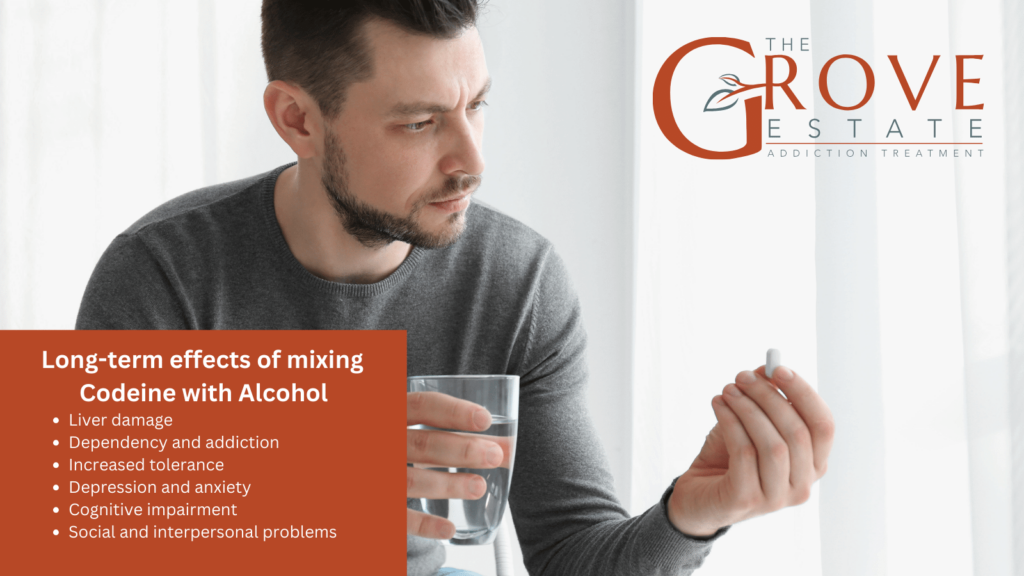The intersection of codeine and alcohol use presents a complex challenge in public health. According to Substance Abuse and Mental Health Services Administration (SAMHSA) in 2021, 26.4% (approximately 2.3 million) of individuals aged 12 and older who misused prescription pain relievers in the United States reported misusing products containing codeine, making it the third most frequently abused prescription.
The dangerous synergistic effects of mixing codeine with alcohol, include the heightened risks of respiratory depression, overdose, and potentially fatal consequences. Understanding these risks is paramount for both individuals using codeine and healthcare professionals, given the drug’s significant abuse potential and the dire outcomes associated with its misuse alongside alcohol.

What Happens When Mixing Alcohol and Codeine?
The combination of alcohol and codeine is a critical issue in public health due to the dangerous interactions between these substances. Codeine, a widely used opioid for its effective pain-relieving and cough suppressant properties. When mixing alcohol and codeine, several serious health risks and effects can occur:
- Increased Sedation and Drowsiness: Both substances depress the central nervous system, leading to enhanced sedative effects, which can impair cognitive and motor functions.
- Respiratory Depression: The combination can significantly slow breathing, potentially leading to respiratory arrest and death.
- Increased Risk of Overdose: The sedative effects of both substances can be additive, increasing the risk of a potentially fatal overdose.
- Heightened Impairment: Cognitive and physical impairment are more severe when these substances are combined, increasing the risk of accidents and injuries.
- Liver Damage: Both alcohol and certain formulations of codeine (e.g., acetaminophen/codeine combinations) can damage the liver, and combining them may increase this risk.
- Compounded Withdrawal Symptoms: Individuals dependent on both substances may experience more severe withdrawal symptoms.
- Dangerous Interactions: Alcohol can interact with codeine to produce unexpected and harmful side effects, such as severe dizziness, confusion, and fainting.
- Increased Risk of Addiction: Mixing substances can lead to a higher risk of developing an addiction or substance use disorder.
The concern over mixing codeine with alcohol has risen as both substances individually depress the central nervous system, and their combined use amplifies these effects, leading to dangerous levels of respiratory depression and potential death. Public health campaigns and medical professionals emphasize the importance of avoiding alcohol consumption while taking codeine to prevent these life-threatening outcomes. This growing awareness aims to reduce the harm associated with the misuse of these substances and underscores the need for vigilance and education regarding the risks of combining opioids with alcohol.
What is Codeine?
Codeine is an opioid pain medication, a type of drug derived from the opium poppy that is used to treat mild to moderately severe pain. It is also effective as a cough suppressant. As an opioid, codeine works by binding to the body’s opioid receptors, which are found in various areas, particularly in the brain and spinal cord, altering the perception of pain and emotional response to pain.
Codeine is available in several forms, including tablets, capsules, and liquid solutions. It is often prescribed alone or in combination with other medications, such as acetaminophen or ibuprofen, enhancing its effectiveness in pain relief or cough suppression. These combination medications are commonly used to treat conditions such as coughs, colds, and dental pain.
Despite its therapeutic uses, codeine also carries a risk of dependence and addiction, particularly with long-term use or misuse. It is classified as a controlled substance in many countries, including the United States, where it is available only with a prescription. The use of codeine, like other opioids, should be closely monitored by a healthcare provider to minimize risks and ensure its safe and effective use.
What is the Interaction of Alcohol with Tylenol?
The interaction of alcohol with Tylenol (acetaminophen) can lead to serious health risks, primarily affecting the liver. Acetaminophen is a widely used over-the-counter medication for pain relief and fever reduction. While generally safe when used according to the recommended dosage, acetaminophen can cause liver damage if taken in large amounts. Alcohol consumption exacerbates this risk because both substances are metabolized by the liver. Chronic alcohol use can induce certain liver enzymes that metabolize acetaminophen into toxic byproducts more rapidly, increasing the risk of liver damage even at lower doses of acetaminophen. Consequently, mixing alcohol with Tylenol can significantly elevate the potential for acute liver failure, a condition that can be life-threatening without prompt treatment.
Can Mixing Alcohol with Tylenol and Codeine Be Lethal?
Risks associated with combining Tylenol (acetaminophen), codeine, and alcohol include severe liver damage, increased risk of overdose, and potentially lethal outcomes. The toxicity arises from the individual and combined effects of these substances:
- Acetaminophen (Tylenol) is hepatotoxic in high doses, meaning it can cause liver damage. The risk is amplified with alcohol consumption, as alcohol increases the liver’s production of the toxic metabolite NAPQI from acetaminophen, leading to liver injury or failure.
- Codeine is an opioid that can depress the central nervous system, leading to decreased respiratory rate, sedation, or even coma in high doses or when mixed with other central nervous system depressants like alcohol.
- Alcohol itself is hepatotoxic and can cause liver damage, especially with chronic use. Combining alcohol with acetaminophen increases the liver’s workload and the potential for liver damage. Additionally, alcohol and codeine together can significantly depress the central nervous system, increasing the risk of respiratory failure.
The combination of these substances can lead to a significantly higher risk of severe liver damage, respiratory depression, and overdose, which can be lethal. The risk of toxicity and overdose increases with the amount consumed and the duration of consumption. It’s crucial to follow medical advice strictly and avoid mixing these substances without consulting healthcare professionals.

What are the Short and Long-Term Effects of Mixing Alcohol and Codeine?
Mixing alcohol and codeine can have severe consequences due to their combined impact on the central nervous system. This dangerous combination can lead to a range of short and long-term effects that jeopardize overall health and well-being.
Short-term risks
- Respiratory Depression: Both alcohol and codeine suppress breathing. Their combination can lead to dangerously slow breathing rates or respiratory arrest.
- Increased Sedation: Enhanced drowsiness and sedation can lead to accidents, falls, and severe injuries due to impaired motor skills and judgment.
- Overdose Risk: The mix can mask the signs of an overdose, as one might not feel the effects of one substance due to the presence of the other, leading to accidental overdose.
Signs of Adverse Reactions:
- Difficulty breathing
- Extreme drowsiness or inability to wake up
- Confusion or delirium
- Nausea and vomiting
- Unusual dizziness or fainting
Long-Term Effects of Mixing Codeine with Alcohol
Long-term use of codeine and alcohol in combination can lead to several chronic health issues, including:
- Liver Damage: Both substances are metabolized by the liver, and their toxic metabolites can cause liver inflammation, scarring, or liver failure over time.
- Dependency and Addiction: Long-term use increases the risk of developing a physical and psychological dependence on both substances, leading to addiction.
- Increased Tolerance: Over time, the body may require higher doses of both substances to achieve the desired effects, leading to increased consumption and heightened risk of overdose.
- Depression and Anxiety: Both substances can exacerbate or lead to the development of anxiety disorders and depression.
- Cognitive Impairment: Chronic use can lead to difficulties with memory, decision-making, and problem-solving skills.
- Social and Interpersonal Problems: The effects on behavior and mood can strain relationships, leading to social isolation and worsening mental health conditions.
The Risk of Overdose from Codeine and Alcohol Combination
The combination of codeine, an opioid pain medication, and alcohol, a central nervous system depressant, significantly increases the risk of overdose. This risk is heightened because both substances individually suppress breathing and impair cognitive functions, and when taken together, these effects are magnified.
How the Combination Increases Overdose Risk
- Synergistic Effect: Alcohol and codeine both depress the central nervous system. When combined, the depressive effects on respiratory and cardiac functions can be multiplicative rather than additive, leading to a much higher risk of life-threatening respiratory depression.
- Impaired Judgment: Alcohol can impair judgment, increasing the likelihood of taking higher doses of codeine than prescribed or combining drugs without considering the risks.
- Tolerance and Dependence: Regular use of either substance can lead to increased tolerance, where higher doses are needed to achieve the same effect, and physical dependence, both of which increase the risk of overdose.
Recognizing Overdose Symptoms
Symptoms of an overdose from mixing codeine and alcohol include:
- Severe Respiratory Depression: Shallow, slow, or stopped breathing.
- Extreme Drowsiness: Inability to stay awake or respond to stimuli.
- Confusion or Delirium: Severe disorientation or hallucinations.
- Cold and Clammy Skin: Particularly on the extremities, indicating circulatory problems.
- Bluish Lips or Fingernails: A sign of oxygen deprivation.
- Vomiting: Especially when unconscious, which could lead to choking.
- Seizures: In severe cases, due to oxygen deprivation or direct toxic effects on the brain.
Recognizing these signs early and seeking immediate medical intervention is crucial to preventing fatal outcomes. If you suspect someone is experiencing an overdose, call emergency services right away and provide as much information as possible about what substances were taken and in what amounts.
Why Do People Mix Codeine and Alcohol?
Mixing codeine with alcohol involves a complex interplay of factors, including the pursuit of enhanced effects, social influences, and the impact of popular culture.
Reasons Behind the Dangerous Combination
- Enhanced Effects: Some individuals mix codeine with alcohol to intensify the euphoric and sedative effects of both substances. Codeine alone can produce feelings of relaxation and euphoria, and when combined with alcohol, these effects are amplified, leading to a more potent high.
- Social and Cultural Influence: The practice is often influenced by peer pressure and the desire to emulate behaviors seen as glamorous or desirable in certain social circles. The combination has been popularized by some musicians, celebrities, and in social media, making it more appealing to individuals looking to connect with those cultural elements.
- Misinformation and Underestimation of Risks: There’s a widespread misconception that because both codeine and alcohol are legal (with codeine being available through prescription), mixing them is not particularly dangerous. This underestimation of risks contributes to the prevalence of this combination.
The Dangers of Purple Drank: A Codeine Cough Syrup Mixture
Purple Drank, also known as Lean, Syrup, or Sizzurp, is a recreational concoction that involves mixing prescription-grade codeine cough syrup with soft drinks like Sprite or Mountain Dew. This combination creates a potent elixir with sedative effects, often consumed in large doses for recreational purposes. Despite its popularity in certain circles and its glorification in popular culture, Purple Drank poses significant health risks.
The misuse of codeine cough syrup can lead to addiction, respiratory depression, and even fatal overdose. Additionally, mixing codeine with alcohol or other drugs further heightens these dangers, increasing the risk of adverse effects and medical complications. It is essential to recognize the serious risks associated with Purple Drank and to avoid its consumption to protect one’s health and well-being.
Alarmingly glorified in popular culture, Purple Drank has been referenced throughout multiple songs and TV shows. It is mentioned in songs by artists like Lil Wayne and Three 6 Mafia.
Rapper Lil Wayne was admitted to the intensive care unit with seizures and unconsciousness caused by extremely high levels of Codeine. Though he survived, he was in critical condition after having his stomach pumped 3 times to remove the drug from his system.

Treatment Options for Codeine and Alcohol Addiction
Treating codeine and alcohol addiction requires a multifaceted approach tailored to individual needs. Common treatment options include:
- Detoxification: Managed detox helps safely navigate withdrawal symptoms.
- Behavioral Therapy: Cognitive-behavioral therapy (CBT) and motivational interviewing (MI) address harmful patterns.
- Medication-Assisted Treatment (MAT): Medications like methadone or naltrexone aid in managing cravings and withdrawal.
- Support Groups: Participation in AA or NA provides peer support and encouragement.
Additionally, rehabilitation programs, whether inpatient or outpatient, offer structured environments for recovery. Aftercare planning ensures continued support post-treatment, critical for long-term sobriety. Seeking professional help is vital to finding the right combination of treatments for successful recovery.
Does mixing codeine with alcohol enhance the pain-relieving effects?
No, combining codeine with alcohol can increase the risk of respiratory depression and other dangerous side effects, rather than enhancing pain relief.
Can a small amount of alcohol be safely consumed while taking codeine?
It’s not recommended to consume any alcohol while taking codeine, even in small amounts, due to the potential for increased sedation, respiratory depression, and other adverse effects.
Does the risk of mixing codeine with alcohol vary depending on the formulation (e.g., pill, liquid)?
While the risk of combining codeine with alcohol remains significant regardless of formulation, the effects may vary slightly depending on the rate of absorption and metabolism. However, caution should be exercised regardless of the form in which codeine is taken.
Can lifestyle changes help reduce the risk of substance dependency?
Lifestyle changes play a crucial role in reducing the risk of substance dependency, including the misuse of alcohol and codeine. Incorporating healthy habits such as regular exercise, maintaining a balanced diet, and engaging in stress-reduction activities can improve overall well-being and reduce the likelihood of turning to substances as a coping mechanism. Fostering strong social connections and seeking support for mental health issues are also vital steps in building resilience against substance dependency.
For individuals seeking guidance on making these changes or understanding the risks associated with substance use, attending drug & alcohol seminars can be incredibly beneficial. These seminars offer valuable information on the impacts of substance use, strategies for prevention, and resources for those struggling with addiction, providing a foundation for informed decisions about alcohol and drug use.
How does the body process alcohol and codeine differently?
The body processes alcohol and codeine through different metabolic pathways, which can lead to varied effects and risks when these substances are combined. Alcohol is primarily metabolized in the liver, where it is broken down into acetaldehyde, a toxic substance, before being further metabolized and excreted. Codeine, on the other hand, is metabolized by the liver into morphine, which then exerts its pain-relieving effects. When alcohol and codeine are taken together, the liver’s workload increases, potentially leading to heightened toxicity and liver damage.
Understanding the metabolism of different substances, including the interaction between alcohol and Marijuana, is essential for recognizing the potential risks and effects of substance use. Both alcohol and marijuana affect the central nervous system, and their combined use can lead to increased impairment and health risks, highlighting the importance of awareness around substance interactions.

Share This Post



